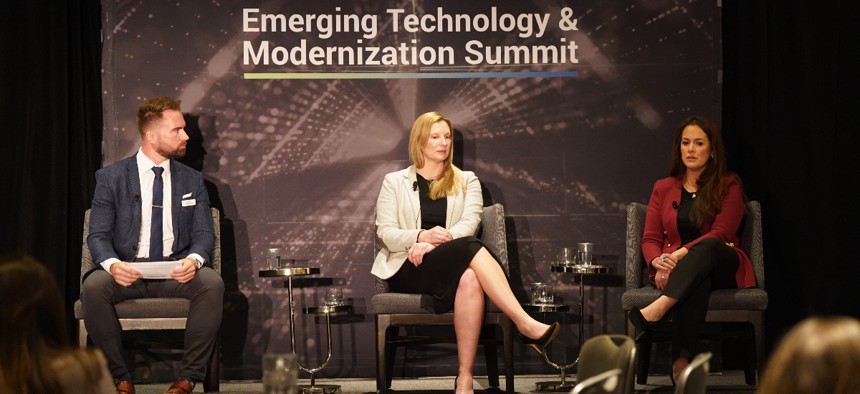Biden’s Budget Proposal Keeps Focus on Improving Federal Customer Experience

Nextgov Executive Editor Frank Konkel (L), TSA Customer Service Branch Manager Nicole French (C) and USDA Chief Customer Experience Officer Simchah Suveyke-Bogin (R) discuss customer experience at the Nextgov Emerging Technology and Modernization Summit. Stephen Kaise/Staff
The budget callout follows several important policy updates.
Federal customer experience is again in the national spotlight following a high-profile callout in President Joe Biden’s fiscal 2024 budget request.
Released last week, the budget proposal includes $500 million to modernize and improve numerous federal services and deliver “customer experiences that are more simple, seamless and secure.” The funding request follows several major policy changes undertaken by the Biden administration, led by the president’s 2021 executive order.
According to a fact sheet released with the budget, the funding includes:
- $2.7 million for the Transportation Security Administration to pilot a Customer Experience Manager model at four airports focused on streamlining passenger screening, easy-to-understand signage, and better collection and review of customer feedback.
- $6.6 million for the Office of Personnel Management to help reduce processing times and improve customer satisfaction, expand a pilot for online retirement applications, and begin to fund additional IT modernization initiatives akin to a case management system.
- $163 million for the Department of State to revamp the delivery of passport services so the public can access core services online.
- $1 million for the United States Forest Service to pilot increased access to digital maps of federal lands on Recreation.gov, as part of implementing directives in the Modernizing Access to our Public Land Act.
- $119 million to support the General Services Administration in continuing its work implementing priority programs such as the U.S. Web Design System, Digital Analytics Program, Digital.gov, Search.gov, and Touchpoints/Feedback Analytics.
The budget proposal also commits to hiring up to 120 new full-time employees “with customer experience and digital product delivery experience” across nine agencies—the departments of Agriculture, Homeland Security, Housing and Urban Development, Interior, Labor, Treasury, Veterans Affairs, the Small Business Administration, the Social Security Administration, the Federal Emergency Management Agency and the Census Bureau. According to the proposal, each agency would stand up its own departmental customer experience office.
“This will enhance capabilities to learn directly from the public and identify pain points, analyze customer feedback and use that information to improve service delivery,” the fact sheet states. “These new hires will support cross-agency life experience projects, customer research and service improvement activities at agencies considered High Impact Service Providers.”
Speaking Thursday at the Emerging Technology & Modernization Summit, hosted by Nextgov and GCN, Nicole French, customer service branch manager at TSA, said the proposed funding would be welcome news should it bear out in Congress.
“We have 177 people who act as customer service managers in the field, but only about nine who have that title,” French said. “This budget proposal will cement four to five of those positions, and if they do well, maybe we’ll get some more.”
TSA plans to conduct a nationwide survey of the agency’s customer experience at 16 airports beginning in May. Airline passengers going through checkpoints will have the option to participate, answering 15 questions. The results, expected by fall, will be shared with the public and could inform future TSA policies.
Simchah Suveyke-Bogin, USDA’s chief customer experience officer, said any additional funding toward customer experience efforts across the sprawling agency will further trust the office has cultivated over the past few years.
“Our current secretary and others before really value trust, and we’re making sure that is a core value or what we are delivering,” said Suveyke-Bogin, who added that her office is small but gradually growing in size. “We have great partners in industry that continue to support us being innovative, from our contact center partners to design partners, and even when it comes to data and measurement. We rely heavily on our workforce and partners.”






